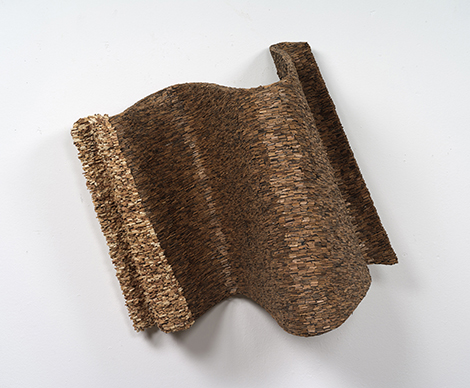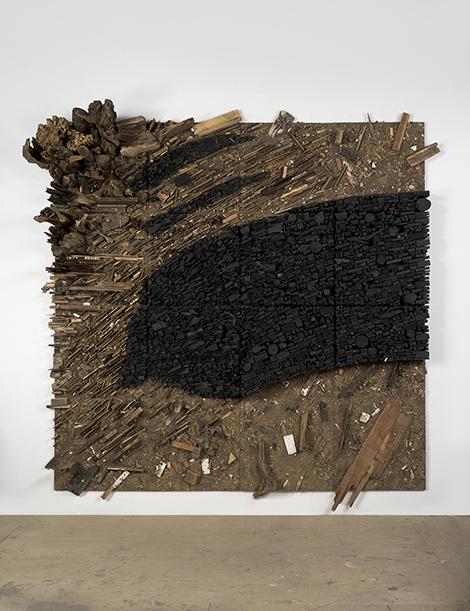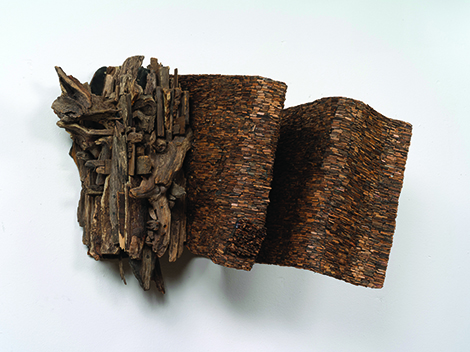New York sculptor Leonardo Drew’s dark and somewhat foreboding constructions of thousands of pieces of wood might seem oppressive, were it not for his elegant forms and subtle wit. Eight wall-hung sculptural assemblages (all works 2014) strongly make the case for art as a handmade object imbued with presence and meaning. They rebut, quietly but firmly, a couple of bad ideas about progressive art as iconoclastic counter-propaganda, solely socio-politically driven, and that how art looks and operates matters less than its “idea,”—i.e., that content trumps style.
Drew’s untitled but numbered works fall into four groupings: abstract field paintings, albeit monochromatic and composed of wooden chips and branches; arrays or grids, with the pictorial field divided into square-format containers, derived from post-minimalist seriality; wave forms that allude to woven fabrics; and architectural fragments, which might be brackets or the tops of columns or pilasters.

Leonardo Drew, Number 33S, 2014. Courtesy of the artist and Anthony Meier Fine Arts, San Francisco, CA, Photo: John Berens, NYC.
The larger of the two ‘painterly’ works is Number 38S, an eight-foot-square field of wooden sticks, detritus from some explosion or collapse, scattered over 16 dirt-colored (or covered) wooden panels that combine into what The New York Times art critic Roberta Smith called “an endless catastrophe seen from above.” A shattered tree stump protrudes at top left. From center right, an oval of darkened, scorched wood flows into the blast zone—composed of vertically arranged stick and rods, tightly compressed, it suggests the congested urban landscape. The smaller one, Number 40S, is a tall, vertical-format rectangle composed of burned wood, here including tree-branch sections, perhaps Central Park, transformed. Down the center of this Louise Nevelson city runs a slender conduit (or Barnett Newman zip) paved with small white wood tiles.

Leonardo Drew, Number 38S, 2014. Courtesy of the artist and Anthony Meier Fine Arts, San Francisco, CA. Photo: John Berens, NYC.
Number 31S is another eight-foot square, although here the 16 components of burnt wood assert themselves as boxes or containers, each containing a trapezoidal flange or concrete footing form of painted white wood, each one individualized. Some appear intact, freshly molded, while others seem to be exploding, or metastasizing with tendrils—and new life?
The wave-form or flag-like pieces, Number 33S and Number 34S, are technical tours de force of Surrealist transformation and dislocation. Three pieces are architectural metaphors—Number 35S, Number 37S and Number 44S—mounted together along the white hallway of the gallery’s historic 1911 Willis Polk house, in a neat bit of site-specific stagecraft that harnesses San Francisco’s boom and bust cycles. These pieces might even be seen as sections of fallen cornice. Even if we successfully repress the seismicity dimensions, these compressed-stick column capitals are imaginative transpositions of nature and culture, reminders that civilizations come and go.
Worrying about Baudrillard’s philosophical “desert of the real” (popularized in The Matrix) seems a fantastical luxury as ecological and economic collapse looms on the horizon. If art galleries seem ever more like boutiques chock-a-block with glossy, beckoning, lifestyle accessories, and museums similarly seem to be devolving into malls or nightclubs, the silent sculptures of Leonardo Drew, in which craftsmanship and creativity speak for themselves, symbolically but powerfully, are a welcome grounding in the value of art as carrier of metaphor and meaning.


